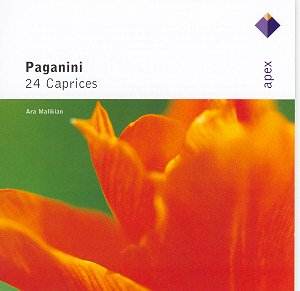Paganini was a hugely significant and interesting
musician, veritably a legend in his own lifetime. The legend was
that his playing was so remarkable in its virtuosity that he was
in league with the devil. And none of his music did more to foster
this reputation than these extraordinary studies.
Captured in vivid sound amid a pleasing acoustic,
Ara Malikiran presents the studies with the full observance of
the repeats Paganini marked in the autograph score. This has obvious
advantages, chief among them the simple fact that Paganini intended
the music to be performed this way and his intentions ought to
be honoured. On CD this means two discs rather than one, but at
bargain price in a slimline box this is not a problem.
The studies vary in approach, of course, since
the intention of covering every aspect of instrumental technique
was of paramount importance to Paganini. Therefore creating the
right sound takes on a special significance, and in this regard
Ara Malikian triumphs. The recent and high quality recorded sound
plays its part too. Perhaps some of the faster tempi could have
been faster still – as in parts of the famous recording by Itzhak
Perlman (EMI) – but allowing for a little more clarity of articulation
affords its own compensations and rewards.
It is in the nature of a recording of a solo
violin that the instrument can acquire a larger than life quality,
and certainly some of the slower numbers – Caprice No. 6 at tempo
Lento, for example – can have this effect. Since Malikian’s sound
is so pleasing this is not the problem it might be, and in any
case adjusting the amplifier’s volume control provides an easy
solution.
As so often with budget releases, the accompanying
documentation leaves much to be desired. There is a short and
interesting essay, but inexplicably in the context of music such
as this, no artist biography whatsoever. Since Ara Malikian is
not an internationally celebrated artist, this omission seems
all the more unfortunate.
All twenty-four Caprices in a single sequence
is a daunting prospect for the listener as well as for the violinist.
They are best heard, I think, either singly or in small groups.
The final Caprice, based on that tune, remains the most
satisfying of them all.
Terry Barfoot
